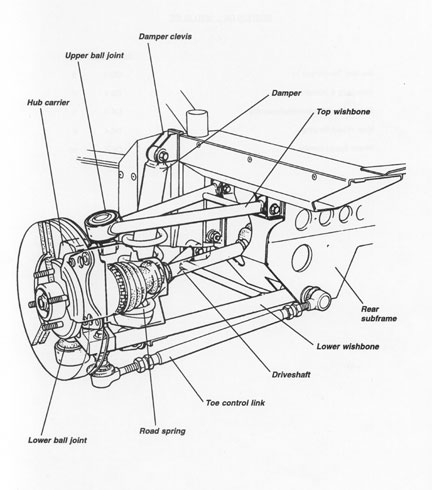I feel the best place to start, is by defining terms, and setting goals.
I feel the need to define terms, because I am still a newb when it comes to suspension dynamics, and the hardest part for me to grasp thus far has been terminology.
Jounce-Upward motion of the wheel relative to the body of the car, the compression of the suspension from it's static position.
Rebound-Downward motion of the car relative to the body of the car, the relaxation of the suspension from it's static position.
Caster-the front to back tilt of the spindle or knuckle relative to a vertical line drawn through the wheel centerline.
Camber-the inward or outward tilt of the wheel relative to a vertical line drawn at the wheel centerline.
Toe-the Pointing of the wheels inward or outward relative to the centerline of the vehicle.
Roll Center-the axis which the front or rear chassis of the vehicle rotates during suspension travel.
Roll axis- The line in between the front and rear roll centers.
Side-view - projection of the physical and constructed aspects of the wheels and suspension onto the longitudinal-vertical plane
End-view -projection of the physical and constructed aspects of the wheels and suspension of one end of a car onto the transverse-vertical plane
Acceleration-the rate of change of velocity. At any point on a trajectory, the magnitude of the acceleration is given by the rate of change of velocity in both magnitude and direction at that point
Recommended reading:
http://www.amazon.com/Tires-Suspension- ... 1560918314
http://www.amazon.com/The-Racing-High-P ... 0768012414
http://www.amazon.com/Tire-Vehicle-Dyna ... 0080970168
http://www.amazon.com/Race-Car-Vehicle- ... GMT2R1S2EZ
Goals:
#1 to make the best use of the tires in the available space. cutting of the sheet metal, including the strut towers, is to be considered acceptable, cutting of the frame rails is not. The engine and transmission cradle, along with the front crossmember, can be completely custom.
#2 is reliability and repair-ability, through the use of off the shelf wear components with no modifications, including but not limited to Wheel bearings, Brake discs, and brake calipers.
The starting point:
I feel the best place to start, is to define the wheel bearing and brake combination to suit goal number 2, as it should be easier to work from the inside out.
Rear bearing options that come to mind:
5x100mm
Stock Fiero
Subaru BRZ or imprezza
5x114.3mm
Pontiac Montana minivan
5x115
GM N body
5x4.75"
4x4 S-10 front wheel bearing. strong, cheap, probably available for a long time.
C6 'vette wheel bearing. strong, 99.99% sure will be available for the foreseeable future. factory proven to >600 hp/600 ft-lb's and 1.15g's @ 3400+ lbs. integral wheel speed sensors.
I'm not above a fabricated knuckle, similar to what CCfiero did

or getting a set of knuckles from/for another car:

My initial questions:
is there any distinct advantage to the 88 fiero rear setup with lateral links and trailing arms, versus a triangulated setup? I guess changes in caster are minimal/negligible through jounce/rebound? I would guess that a triangulated setup would be smaller and lighter than as the 88 fiero setup.
is there a readily available modeling software that can demonstrate how a design will articulate?
Lets get some stuff on paper and make a badass car!


